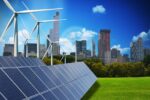What’s the Approach to Improve to Solar-powered Aircraft

Solar power offers uncrewed, solar-powered aircraft (UAVs) the opportunity of infinite resistance. Some research is rolling out methods for achieve eternal flight by maximizing the potency of the sun’s sun sun rays and flying based on its azimuthal angles. However, passing along a method transporting out a Sun consumes more energy to sustain horizontal flight. These studies optimizes the general power factor using a mission profile’s configuration for the optimal use of solar power. A comprehensive simulation aims to optimize and restructure the UAV mission profile phases and define the best idea of the take-off, ascent, and descent phases and so maximize solar power. In addition, instead of maximizing the Sun’s slope, a round vertical flight path was applied. This method enhances the internet power factor by 30.84% in comparison to other techniques. Consequently, the responsibility within the battery may be considerably reduced by 75.23%. In summary, the suggested configuration within the mission profile through getting a perfect power-track planning factor effectively extends the whole process of unmanned aircraft.

Introduction
Presently, high UAV resistance remains achieved by collecting solar power by solar panels [1-8]. The Sun’s Sun sun rays was utilized just as one endless source for longer term UAV flight. However, solar power panels could only generate energy at certain occasions during the day. Therefore, batteries are really introduced as being a secondary energy source to keep excess energy which can be discharged at night time. In addition, the very best charge of the gravitational descent path at night time was regarded as a effective approach to improving flight resistance. The power stored as potential gravitational energy and bought at height can be utilized using the UAV to glide at night time with no electrical source.
Some studies concentrate on UAV kinematics to improve UAV performance. The career of incidence of UAV is important to uncover the positioning of incidence under the sun round the solar power by having an optimal harvest of solar power. Other studies determine the career of incidence along with the position of UAV during flight maneuvers to pay for that relative position under the sun for the maximum harvest of solar power. However, the flight path that “follows” the sun’s sun sun rays consumes additional energy.

A means of trajectory planning, also known as Energy Management Strategy (EMS), remains studied to cope with UAV’s effective trajectory using the above methods. The EMS idea should be to divide the circuit into three phases and make use of solar power, which may be stored partially as potential gravitational energy throughout the day. The UAV collects solar power throughout the day and acquires gravitational energy based in the sliding phase.
The Sun’s maximum slope position remains based on altering UAV’s slope position, that has introduced to greater energy consumption because of the have to get the street transporting out a Sun [12]. Saghar and Mehran also recommended the chance energy collected with the growth phase might be saved later. Other studies focused on the trajectory within the the top vertical circular cylinder with enhanced ascent and descent periods to boost the wings’ exposure to the sun. However, the phases from the mission have not yet been enhanced for a lot better capacity uncrewed aircraft.
Some studies report that the net power gain may be maximized by mention of the local spectral density of solar power from weather forecasts. However, flexible path planning remains performed, in which the path was selected while using cost function. This step enables unmanned solar-powered aircraft (UAVs) to perform a perpetual flight additionally to allow planetary missions, using discretization to resolve optimal trajectory close-ups.






